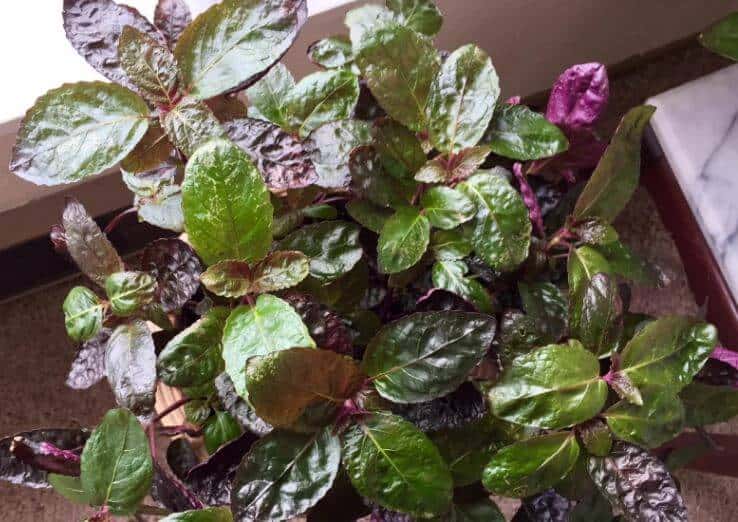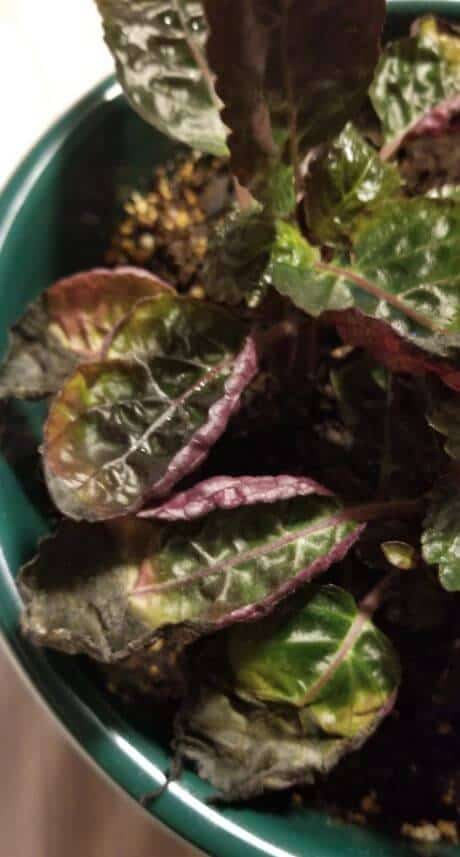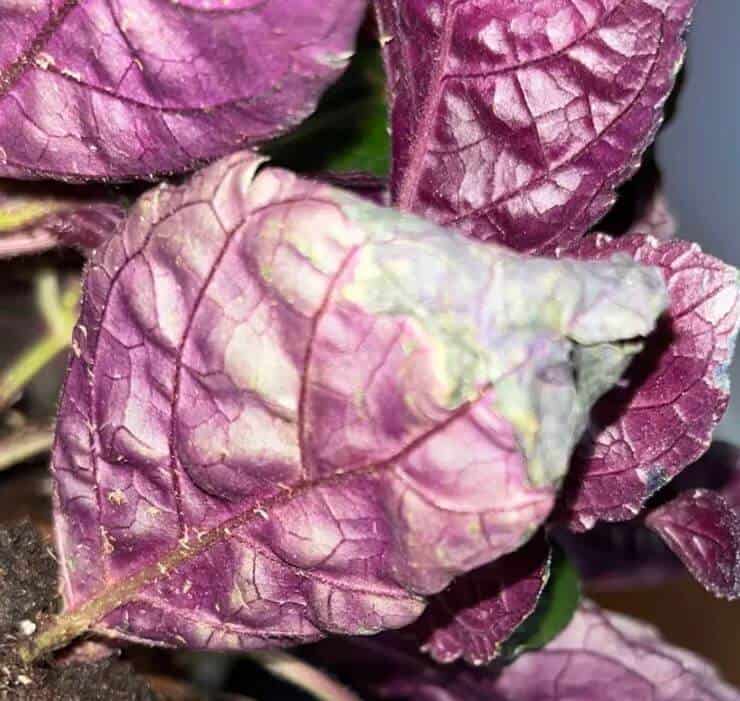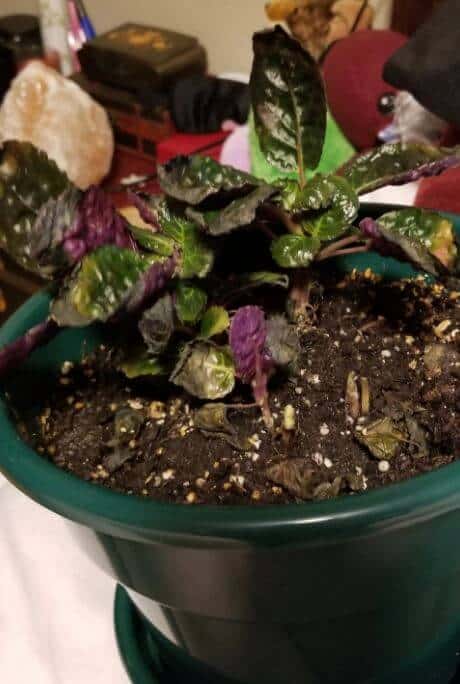Last Updated on September 9, 2023 by a Friendly Gardener
For those who love textured colorful houseplants, the Purple Waffle plant is a perfect addition to any indoor garden. Bold purple coupled with a waffle texture makes this a beautiful décor accent. The Hemigraphis Alternata is a compact bushy plant that has a mound-like growth habit. It’s perfect in a pot or can be used as a ground cover outdoors.
Purple waffle plants are also known as Metal Leaf plants, Waffle plants, Red Ivy, and Red Flame Ivy.
Native to Java, they are non-toxic to both humans and family pets. There are various cultivars of the Hemigraphis Alternata including the Red Flame Ivy which features deep purple leaves with green undersides, the Belgian Waffle which features cream and green foliage with purple undersides, and the pretty Snow White Waffle plant that boasts green and white leaves with pink undersides.
Purple Waffle Plant Care

Green leaf tops paired with red or purple undersides make ruffled foliage unique on this tropical delight. They are understory pants in tropical rain forests, so purple waffle care should replicate conditions in their natural habitat.
Soil
Waffle plants thrive in quality potting soil as long as it is well-draining. Add perlite or pumice to potting soil to ensure drainage and aeration. Poor drainage can create conditions ideal for fungal infections or root rot. These plants do not do well when rootbound, so roots peeking out of drainage holes, or the soil surface indicate it’s time to repot. Select a pot that is one to two inches larger than the current container.
Light
Waffle plants need generous amounts of bright but rigorously indirect light. Should light exposure be insufficient, the vibrant purple for which they are popular will begin to fade. Direct sunlight should be avoided at all costs so that leaves do not scorch.
Water
Generally speaking, a water plant needs to be watered approximately once weekly or when the top two inches of the soil bed feel dry. Poke your finger into the soil bed to about the second knuckle to verify moisture content. In warmer environmental temperatures, this plant makes require watering as frequently as every other day.
Humidity
The Waffle plant adores humidity as a jungle native. The appearance of brown tips will usually indicate that humidity levels are too low. The addition of a pebble tray or misting will help if you do not have a space humidifier. Consider grouping several plants as plant transpiration will contribute to creating a microclimate. You can also place this lovely creature in your bathroom where the humidity is naturally higher.
Temperature
Waffle plants enjoy warmer weather with temperatures between 65° and 80°F. They can be moved outdoors to a shaded porch, deck, or patio in warmer months. As soon as temperatures drop below 50°F. they should be returned indoors.
Fertilization
Ideally, Waffle plants can be fed once monthly during warmer months when the plant is in its growing season. Be careful to avoid root burn from overfertilization. Consider diluting the recommended dose of liquid fertilizer to half strength and applying it after you have watered the plant.
Waffle Plant Propagation
Waffle plants are easy to propagate using water. Look for a healthy stem preferably with new growth and trim it off with sterilized gardening scissors. Remove all the lower foliage from the stem. Place your stem in a transparent glass jar or vase positioning two or three bare leaf nodes under water and placing it in bright, indirect light. Change the water weekly or more often if necessary. Roots should begin forming in two to four weeks. Once the roots have grown to at least two inches in length, your new plant can be transplanted into soil.
Waffle Plant Problems

These plants are easy to care for if the minimum environmental conditions are met. If not, you may witness a variety of symptoms where the plant communicates its distress.
-
Purple Waffle plant crispy leaves

Waffle plants are named for their puckered leaf texture, so this texture should not be misinterpreted. This unique texture is not the same thing as your plant developing crispy leaves. Crispy implies dryness and a tendency to crumble when touched.
If your plant develops crispy leaves, it is generally communicating that it is thirsty, however, too much sun can also be the cause as can low humidity levels. Verify the soil moisture and location for excessive sun exposure. If these two conditions are met, consider low humidity levels. You may want to acquire a humidity meter if you have any doubts. Snow white waffle plant crispy leaves can be particularly unsettling due to their delicate coloring. Crispy leaves should be trimmed off as they cannot recover.
-
Limp Purple Waffle plants
Waffle plants wilt and appear limp when they are thirsty. Give your plant a good soaking and it should perk up quickly. Be sure to allow all excess water to drain from the container.
-
Curling Purple Waffle plant leaves

Curling leaves indicate a watering issue. If foliage begins to shrivel it is not receiving enough water. Mushy leaves indicate overwatering.
-
A Leggy Purple Waffle plant

Leggy growth is generally a plant response to insufficient sunlight. Plants reach for light becoming leggy in the process. Once leggy, old stems will not produce new foliage. Pune leggy stems and use them for propagation.
A Final Thought
Purple waffle plant indoor care is not complicated, nor does it require a great deal of time. Soil beds need to remain moist but never soggy, and environmental temperatures should remain above 50°F.
The light should be generous but rigorously indirect and an occasional feeding during the growing season will boost nutrients. That’s all you need to provide to enjoy this plant’s stunning foliage.

